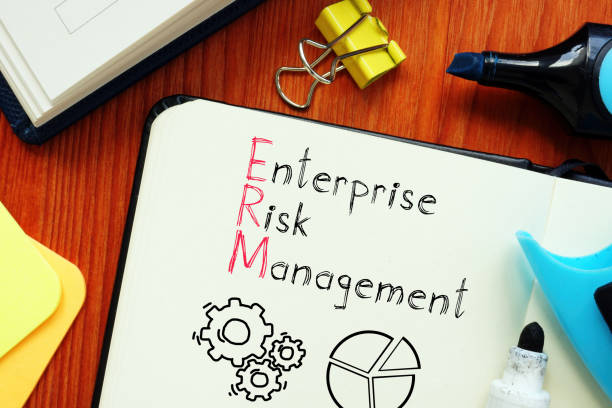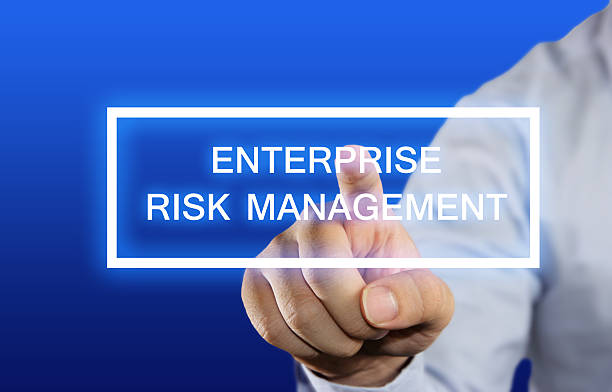Enterprise Risk Management Plan – Risk is inevitable in any business or organization. It can arise from various sources, such as market fluctuations, operational failures, natural disasters, cyberattacks, regulatory changes, and human errors. Risk can also have positive or negative impacts on the organization’s objectives, such as profitability, growth, reputation, customer satisfaction, and social responsibility. Therefore, it is crucial for organizations to manage risk effectively and efficiently.
However, managing risk is not a simple task. It requires a systematic and holistic approach that considers the interrelationships and interdependencies among various risks and their potential effects on the organization’s performance and value. This approach is called enterprise risk management (ERM).
In this post, we will explain what ERM is, why it is important, how to develop an ERM plan, and how to evaluate an ERM plan. We will also provide some examples and tips for implementing ERM in your organization. By the end of this post, you will have a better understanding of ERM and its benefits for your organization.
READ ALSO
- Insurance Liability Car: What You Need to Know
- Jones Act Law: What You Need to Know
- Options Trading Lessons: A Beginner’s Guide
- Best Family Life Insurance Companies of 2023
- PenFed Business Account: A Guide for Non-Government Organizations
- How to Sell Your Home Quickly: 6 Tips for Success
- What is PITI and why is it important for homebuyers?
What is Enterprise Risk Management?
Enterprise risk management (ERM) is a methodology that looks at risk management strategically from the perspective of the entire firm or organization. It is a top-down strategy that aims to identify, assess, and prepare for potential losses, dangers, hazards, and other potential for harm that may interfere with an organization’s operations and objectives and/or lead to losses.
ERM is essential for public and private companies to approach risk management with confidence. An effective risk management method, if integrated properly, can result in substantial cost savings for the company.
Why is Enterprise Risk Management Important?
Enterprise risk management is important because it can help organizations to:
- Align their risk appetite and strategy: ERM can help organizations define their risk tolerance and align it with their strategic goals and vision.
- Enhance risk response decisions: ERM can help organizations select the most appropriate risk response strategies, such as avoidance, reduction, sharing, or acceptance.
- Reduce operational surprises and losses: ERM can help organizations identify and monitor the risks that may affect their operations and performance, and take proactive measures to prevent or mitigate them.
- Identify and manage multiple and cross-enterprise risks: ERM can help organizations recognize the interdependencies and correlations among various risks across different business units, functions, and processes, and manage them holistically.
- Seize opportunities: ERM can help organizations identify and exploit the opportunities that arise from uncertainty and change.
- Improve stakeholder confidence and trust: ERM can help organizations communicate their risk management practices and outcomes to their stakeholders, such as investors, customers, regulators, employees, and society.
How to Develop an Enterprise Risk Management Plan?
An enterprise risk management plan is a document that outlines the processes and procedures for implementing ERM in an organization. It typically includes the following elements:
- Strategy/objective setting: This element defines the organization’s mission, vision, values, goals, and objectives, as well as its risk appetite and tolerance. It also establishes the roles and responsibilities of the board of directors, senior management, risk owners, and other stakeholders in ERM.
- Risk identification: This element identifies the sources and causes of risks that may affect the organization’s objectives. It also considers the potential impacts and consequences of those risks. Risk identification can be done using various methods, such as brainstorming, interviews, surveys, checklists, scenario analysis, etc.
- Risk assessment: This element evaluates the likelihood and severity of each identified risk. It also prioritizes the risks based on their significance and urgency. Risk assessment can be done using various tools, such as matrices, heat maps, scorecards, etc.
- Risk response: This element selects and implements the appropriate risk response strategies for each prioritized risk. It also allocates the resources and assigns the accountabilities for executing those strategies. Risk response can be done using various techniques, such as action plans, contingency plans, policies, procedures, controls, etc.
- Communication/monitoring: This element communicates the ERM plan and its results to the relevant stakeholders. It also monitors the performance and effectiveness of the ERM plan and its components. Communication/monitoring can be done using various mechanisms, such as reports, dashboards, audits, reviews, feedback, etc.
How to Evaluate an Enterprise Risk Management Plan?
An enterprise risk management plan should be evaluated periodically to ensure its relevance, adequacy, efficiency, and effectiveness. The evaluation should consider the following aspects:
- Alignment: The ERM plan should be aligned with the organization’s strategy/objective-setting element. It should reflect the organization’s mission, vision, values, goals, objectives, risk appetite, and tolerance.
- Completeness: The ERM plan should cover all the relevant risks that may affect the organization’s objectives. It should also include all the necessary elements of ERM, such as identification, assessment, response, and communication/monitoring.
- Consistency: The ERM plan should be consistent across different levels and units of the organization. It should also be consistent with the best practices and standards of ERM, such as COSO, ISO, etc.
- Effectiveness: The ERM plan should be effective in achieving its intended outcomes. It should reduce or eliminate the negative impacts of risks and enhance or create the positive impacts of opportunities.
- Efficiency: The ERM plan should be efficient in utilizing its resources. It should optimize the costs and benefits of ERM activities and avoid waste and duplication.
In conclusion, Enterprise risk management is a methodology that looks at risk management strategically from the perspective of the entire firm or organization. It can help organizations to align their risk appetite and strategy, enhance risk response decisions, reduce operational surprises and losses, identify and manage multiple and cross-enterprise risks, seize opportunities, and improve stakeholder confidence and trust.
An enterprise risk management plan is a document that outlines the processes and procedures for implementing ERM in an organization. It typically includes the elements of strategy/objective setting, risk identification, risk assessment, risk response, and communication/monitoring. An enterprise risk management plan should be evaluated periodically to ensure its alignment, completeness, consistency, effectiveness, and efficiency.
Enterprise Risk Management Plan: Frequently Asked Questions (FAQs)
What are the 5 components of ERM?
The Enterprise Risk Management (ERM) process includes five specific elements:
- Strategy/Objective Setting: This involves setting the overall goals and objectives of the organization, which will guide the ERM process.
- Risk Identification: This involves identifying potential risks that could prevent the organization from achieving its objectives.
- Risk Assessment: This involves evaluating the identified risks in terms of their potential impact and the likelihood of their occurrence.
- Risk Response: This involves deciding how to respond to each risk, whether by accepting it, avoiding it, reducing it, or sharing it.
- Communication/Monitoring: This involves communicating about the risks and monitoring them on an ongoing basis to ensure that the ERM process is effective.
How do you write an enterprise risk management plan?
Creating an Enterprise Risk Management (ERM) plan involves several key steps:
- Identify the Risks: List and assess all of the risks that your business may face. This includes anything from natural disasters to cyberattacks.
- Risk Analysis: Identify potential risks, then document and prioritize them. Assess the frequency and severity of these exposures.
- Evaluate and Assess: Evaluate the consequence, impact, and probability of each potential risk.
- Assign Roles and Responsibilities: Assign a responsible person to monitor each risk and take action, if needed.
- Mitigate the Risks: Once you have identified the risks, you need to come up with ways to mitigate them. This could include alternative approaches or process improvements.
- Implement the Plan: Choose an alternative and implement it.
- Monitor the Implementation: Monitor the implementation and adjust as needed.
Remember, the fidelity of your risk management plan will vary depending on the nature of your project and the standard operating procedures that your organization uses. A well-implemented ERM system could set the foundation for many high-quality, long-term client relationships.
What is ERM basic framework?
Enterprise Risk Management (ERM) is a type of process management strategy that seeks to identify, understand, and prepare for the kinds of dangers, hazards, and other potential deviations from standard operating procedures that could be perceived as risks.
The basic framework of ERM includes several key components:
- Governance and Culture: This involves the overall governance structure and culture of risk management within the organization.
- Strategy & Objective Setting: This involves setting the overall goals and objectives of the organization, which will guide the ERM process.
- Performance: This involves the execution of chosen risk responses and how well the organization is performing in managing its risks.
- Review & Revision: This involves reviewing and updating the risk management process as necessary.
- Information, Communication & Reporting: This involves communicating about the risks and monitoring them on an ongoing basis to ensure that the ERM process is effective.
These components are principles-based, and each contains a series of principles necessary for effective ERM. The strategic framework you choose will depend on your industry, business goals, organizational structure, technology infrastructure, and available resources.

